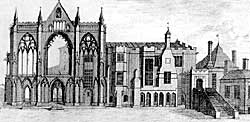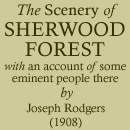< Previous | Contents | Next >
NEWSTEAD AND ANNESLEY
 The west front of Newstead Abbey in 1720.
The west front of Newstead Abbey in 1720.Newstead, the Monastery of Sherwood Forest, was founded by Henry II. in contrition for the murder of Thomas a Becket, as a priory of Black Canons of the order of St. Augustine, who professed great austerity of life. It was frequently visited by the Kings of England, and was richly endowed by many friends ; among others, Edward I., in 1304, granted thirty-eight acres of the land in Sherwood to this convent.
In the early years of the last century, when Washington Irving was on a visit to Colonel Wildman at Newstead, he described the Abbey as " one of the finest specimens in existence of those quaint and romantic piles, half castle, half convent, which remain as monuments of the olden times of England. It stands, too, in the midst of a legendary neighbourhood; being in the heart of Sherwood, and surrounded by the haunts of Robin Hood and his band of outlaws, so famous in ancient ballad and nursery tale. It is true the forest scarcely exists now but in name, and the tract of country over which it once extended its broad solitudes and shades, is now an open and smiling region, cultivated with parks and farms, and enlivened with villages."
The family of the Byrons, into whose possession at the dissolution of the monasteries the Abbey came, is of great antiquity. In the reign of William the Conqueror they had large possessions in various parts of England. Ralph de Byron, who was the direct ancestor of the present Lord Byron, held Manors in Nottinghamshire and Derbyshire in the twentieth year of the Conqueror's reign. To this Ralph succeeded Hugh de Byron, who was lord of the Castle of Horestan, and in the reign of King Stephen gave to the monastery of Lenton the church of Oscington. Another Hugh de Byron, also Lord of Horestan, in the reign of Henry II., being wishful to lead a holy life, professed himself a monk, and held the hermitage of Kersale, belonging to the priory of Lenton.
In 1485, Sir John Byron of Clayton, taking part with Henry, Earl of Richmond (afterwards Henry VII.), received the honour of knighthood soon after the Earl's landing at Milford, and was present at the battle of Bosworth Field. Byron was appointed Constable of Nottingham Castle, and Master of the Forest of Sherwood. He died without issue, leaving his brother Nicholas his heir, who was created a Knight of the Bath on the occasion of the marriage of Prince Arthur in 1501. Sir Nicholas Byron married Joan, daughter of Sir John Bushier, and died in 1503-4, leaving John his son and heir, and five daughters, the youngest of whom, Dorothy, married Edmund Pierrepont, of Holme Pierrepont, in Notts. His only son, Sir John Byron, on the dissolution of the monasteries had a grant by Henry VIII., in 1540, of the Priory of Newstead, with the Manor and Rectory of Papilwick and the surrounding closes about the priory and commons in Ravenshede and Kygell, in the forest. From that time Newstead became the principal seat of the family, and passed in regular descent to John, the first Lord Byron, who was Lieutenant of the Tower in 1641. On the breaking out of the rebellion in 1642, Byron joined the King when he hoisted his standard at Nottingham, with a body of men-at-arms and a large sum of money for the King's service. After the battle of Newbury, Byron was rewarded for his services by the title of Lord Byron of Rochdale. During the time of the Commonwealth he joined the Queen's Court at Paris, and was appointed superintendent-general of the household of the Duke of York. His lordship died without issue in 1652, and was succeeded by Richard, his next brother, the second Lord Byron, who was conspicuous for his valour at the battle of Edgehill. He married, first, Elizabeth, daughter of George Rossel, by whom he had William, his son and heir, and four other sons who died young, and five daughters. He married secondly, Elizabeth, youngest daughter of Sir George Booth, of Dunham Massey, but by her he had no issue. He died in 1679, and was interred at Hucknall Torkard, where a monument is erected to his memory.1 William, third Lord Byron, married Elizabeth, daughter of John, Lord Chaworth, and by her had ten children. He died on November 13, 1695,. and was buried at Hucknall Torkard. William, his successor, the fourth Lord, was one of the gentlemen of the bedchamber to George, Prince of Denmark. He married as his second wife the Lady Frances Williamina, daughter of William Bentinck, Earl of Portland, and by her he had three sons. He married thirdly, Frances, daughter of Lord Berkeley, of Stratton. William, the fifth Lord Byron, was born in 1722. John, brother of the fifth Lord, was born in 1723, afterwards Admiral Byron. Isabella, daughter of the fourth Lord Byron, became wife of the fourth, and mother of the fifth Earl of Carlisle.2
The fifth Lord, in his father's lifetime, took early to the sea service. In 1738 he was appointed lieutenant of his Majesty's ship Falkland, and afterwards of the Victory, which he had the good fortune to leave just before the great ship was lost. He succeeded to the title and estates in 1736, and is represented as a man of irritable passions and vindictive temper, in the indulgence of which an incident occurred that gave a turn to his whole character and life; and, indeed, affected the fortunes of the Abbey. He quarrelled with his neighbour, Mr. Chaworth, the proprietor of Annesley Hall, his kinsman and friend. Being together in London, in 1765, in a chamber of the Star and Garter Tavern in Pall Mall, Byron insisted on settling their quarrel upon the spot by single combat. They fought without seconds, by the dim light of a candle, and Mr. Chaworth, although the most expert swordsman, was mortally wounded. Lord Byron was committed to the Tower, and afterwards tried before the House of Lords, where he was found guilty of manslaughter, but exempted from punishment as a peer. He retired, a marked man, to the Abbey, where he shut himself up to brood over his disgrace ; grew gloomy, morose, and indulged in fits of passion that made him the theme of rural wonder. It is said that he threw Lady Byron into the lake in front of the Abbey, where she would have been drowned but for the timely aid of the gardener. Being displeased at the marriage of his son and heir, he displayed inordinate malignity towards him. Not being able to cut off the succession to the estate, he endeavoured to injure it as much as possible, so that it might come a mere wreck into his hands. He was baffled in this unnatural revenge by the premature death of his son, and passed the remainder of his days in his deserted and dilapidated halls, brooding amidst the scenes he had laid desolate. He was spoken of as the "wicked lord"; he encumbered his estates and made a sale of the Rochdale property. His children and his only grandson (the son of his son by the daughter of his brother John, the Admiral) died before him. Admiral Byron had two sons—John, the father of the poet, and George Anson (ancestor of the present peer), and three daughters, one of whom became wife of her cousin, the son of the fifth Lord ; another married Colonel Leigh, by whom she was mother of another Colonel Leigh, who married his cousin Augusta, daughter of John Byron, the Admiral's eldest son. This John Byron was known as " Mad Jack." He married the Marchioness of Carnarvon after her divorce from the Duke of Leeds. She became Baroness Conyers on the death of her father; and he had by her a daughter Augusta, who married Colonel Leigh in 1807. Lady Conyers' death, in France, deprived her husband of an income of £4,000 a year. He soon after met at Bath a Miss Catherine Gordon, of Gicht, with a fortune of £23,000. The pair were married at St. Michael's Church in that city, in 1785. John Byron took his second wife to France, squandered a great part of her property, and returned to England, where their only child, George Gordon, was born in Holies Street, London.
< Previous | Contents | Next >
1 The inscription
on this monument concludes as follows: "In the same vault is
interred the Lady
Elizabeth, his first wife, ... by whom he had ten children; and the
Lady Elizabeth, his second wife, daughter to Sir George Booth, Bart.,
who appointed this monument to be erected to the memory of her dear
husband, and, for her great piety and goodness, acquired a name better
than that of sons and daughters."
2 Collins' Peerage of England.
